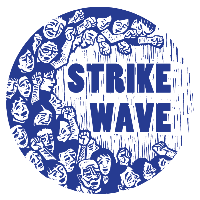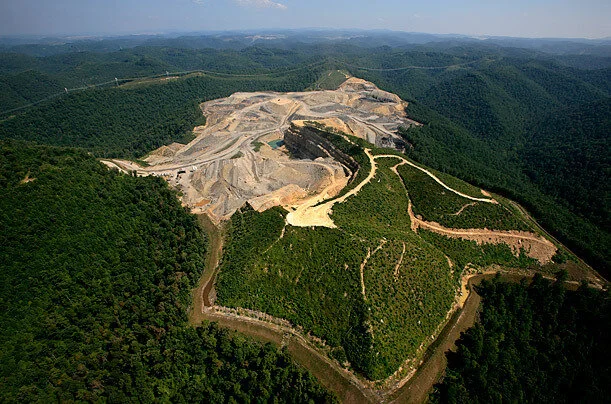Long Hours, Sleepless Nights: Nonprofit Workers Unionize in the Appalachian Coalfields
by Caitlin Myers
A mountaintop removal coal mine in West Virginia. Source: TIME Magazine
Nonprofit workers can be a self-abnegating bunch. As a sector tasked with solving the world’s ills in ways the state can’t or won’t, from filling gaps in social services and campaigning for environmental justice to running charities and educational programs to ostensibly end poverty, nonprofits can induce in their workers a sense of moral obligation not to complain. After all, almost everyone else is worse off, right?
That sense of obligation kept the staff of one West Virginia environmental nonprofit quiet for many years. As paid community organizers for the Ohio Valley Environmental Coalition (OVEC), their principal duty was to organizational members, with whom they fought against mountaintop removal coal mining, natural gas development, and petrochemical buildout through lobbying, direct action, and sustained campaign work. In coalitions such as the Alliance for Appalachia and Reimagine Appalachia, OVEC organizers have contributed to policy proposals and lobbying efforts designed to bring the region an explicitly pro-labor, ecologically sustainable economic transition away from coal.
When he was hired, Dustin White was thrilled to be able to dedicate his life to the fight against strip mining, and like many organizers, built a deep and complex network of relationships in communities like the one that raised him. But, he says, paid organizing is time-consuming, travel-intensive, and deeply emotional work, and he found it draining to a degree he felt management simply didn’t understand.
“Self care ended up being work, too,” said White. As a result of long-term issues with burnout, he and others on staff privately reached out to the Industrial Workers of the World (IWW) in the winter, and hoped to go public on Earth Day.
“I have had long work hours, sleepless nights, countless hours on the road, hundreds of blisters on my feet, and more during my time with OVEC,” White wrote in a letter to the staff and board. “Time after time I have been told that we trust and support each other and our board of directors would always have our back.”
A staff member spilled the beans early, though. According to White, management was incensed, and after months of vitriol he and fellow staffer Brendan Muckian Bates were fired. White was fired allegedly for violating the organizational handbook’s civility rules, and Bates for organizing as a manager. Both were prominent in the union effort, though, and believe management’s goal was to discourage others involved in the unionization effort. White had experienced a series of health problems; Bates was a new father. But the lesson from this historically pro-labor organization was this: unions are great for coal miners, but you don’t need one. You have it easy.
***
The deployment of nonprofits in the fight against Appalachian poverty dates back to Lyndon B. Johnson, and the struggle of nonprofit workers for their rights and the rights of people they work with is almost as old. In Appalachia, much of the current ecosystem of nonprofits dates back to the 1960s-era War on Poverty, when funding was established to fight poverty through community service. Programs like Volunteers in Service to America, now known as the VISTA program under the Americorps umbrella, sent legions of youth on secular mission trips to build schools, work food pantries, and teach literacy. The precursor to the current version of this program was known as the Appalachian Volunteers.
Those job opportunities were expected to draw college students, and were designed to teach the privileged about poverty by setting the wage to the exact poverty line of the region in which they worked. In reality, many of the workers in the program were locals from the coalfields who quickly realized the band-aids offered by the VISTA program weren’t ever going to end poverty when coal barons, other local businessmen, and corrupt public officials still held power. In eastern Kentucky, the Pike County sheriff charged the Appalachian Volunteers with sedition after a series of anti-strip mining actions and raided the homes of several volunteers. In West Virginia, formal federal support of the Appalachian Volunteers program was pulled after members called for fairness in local elections and demanded poor peoples’ representation in local community action agencies. Many of the Appalachian Volunteers went on to work for unions, feeling that nonprofit work purposefully prevented them from addressing any of the underlying causes of poverty.
Today, VISTA workers in Central Appalachia are as likely to be locals as college students from outside the region. The same is true for nonprofit staff generally in the region. Many of the organizers at OVEC are West Virginia born and bred, including White, who grew up in a family he describes as teetering precariously between working class and poor.
While environmental organizations like OVEC are now less restricted from transformative work, many organizing staff feel a similar disconnect between such organizations’ stated goals and actions towards material change in Appalachian communities.
Multiple organizers described a dynamic in which organizers like White, who were hired locally and come from working-class backgrounds, overworked themselves and burnt out quickly while the management and board, who tended to be from upper-middle class or white-collar backgrounds, held their positions for a much longer time.
In organizations like OVEC, organizers don’t have much separation from their members; some have even been members. Members’ concerns feel personal, especially when they are worsened by organizer burnout. “Promises have been broken,” said one OVEC organizer, who felt rebuffed by management when they brought member concerns to the table. On the one hand, they said, the organization promised funders they would “save Appalachia,” but after years of staff turnover and interrupted projects, “many [community members] don’t want anything to do with you.”
Maxim Baru, an IWW representative, says the needs of the population served are often leveraged against organizing nonprofit workers as a way to guilt them away from unionism. “Employers claim that people are indispensable, that you’re distracting from the mission, while saying you’re totally replaceable,” Baru said.
“Nonprofit work fills in where the state falls back,” Baru added. It’s work that can feel critical—harm reduction, social services, and other gaps left by corruption and lack of tax revenue, especially in economically stressed states like West Virginia. When your work might save lives, it’s hard to feel like you can take a break to focus on your own rights as a worker.
Bates hopes that OVEC can be a lodestar for other Appalachian nonprofits. “The progressive world in West Virginia is very small,” he said, alluding to other incidents that have rippled through the community. In one case, according to Bates, an organization called WV FREE was accused by Black staff members of tokenizing them during election season, only to pass them over for training and promotion. He also noted a set of incidents at Our Future WV, where the only trans organizer was fired, and he heard multiple complaints from staff about low pay and lack of benefits—unfortunately common conditions in small nonprofits with contract staff.
These events, said Bates, greatly diminished the organizations’ esteem in the regional community organizing world, and many severed ties with them. That is pointedly not the goal of the OVEC staffers. They want to save the organization, and its work. “We are OVEC,” says Bates. If his work is to teach people to fight for their rights and be better advocates for themselves, why not lead by example?
In the early days, board members who were sympathetic or leaning sympathetic to the union effort resigned, including the only Black board member, who called out the organization’s culture of white supremacy in her resignation letter as evidence of the organization faltering in its mission. The vice chair of the board also resigned and cited, in a Facebook post, the “aggressive” response to the union drive. Multiple staff asked to remain anonymous for this story due to fear of retaliation, and Bates and White sent along copies of deeply angry emails from the most vehemently anti-union board member.
However, in a statement executive director Vivian Stockman congratulated the union on their success. “I know that change is one of the few things we can count on,” said Stockman, “and that learning from change is essential to any kind of transformative work; in our case the work is safeguarding and improving our literal environment—the air, land, and water—as well as the social justice environment.”
On July 14, a majority of OVEC workers voted to certify their union. Coalitions OVEC participated in have distanced themselves from the organization, or are discussing doing so, until the leadership shifts its attitude towards the union drive. Former board members say that despite the recognition, OVEC’s culture will have to shift if it is to be both a productive and healthy work environment, and an organization that can truly stake a claim in fighting for workers in Appalachia.
Perhaps, at least, Appalachian nonprofits are learning what can be fairly expected of staff, and staff in turn are learning what it is possible for them to ask for. Some, such as Kentuckians for the Commonwealth, unionized in recent years; others are engaged in the process of exploring what unionization may look like for them, with some expected to go public with their campaigns in the coming months.
Caitlin Myers is a nonprofit worker, writer and audio producer in Whitesburg, Kentucky and Knoxville, Tennessee.

